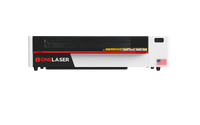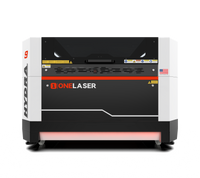If you’ve been running your laser engraver non-stop, you might notice your honeycomb laser bed looking… well, a little gross. Over time, residue builds up from cutting and engraving, which can cause burn marks on the back of your projects and even affect your machine’s performance.
Key Takeaway
In this guide, Brandt Workman, owner of the YouTube channel Bearded Builds Co, will walk you through how to clean honeycomb laser bed surfaces effectively. His method uses common tools, affordable cleaning products, and a pressure washer to restore your bed to a much cleaner state.
Whether you’re looking for tips on cleaning laser cutter honeycomb bed parts for maintenance or tackling a seriously grimy bed, this step-by-step will help you keep your laser running smoothly.
1. Why Cleaning Your Honeycomb Laser Bed Matters
Before diving into the process, let’s talk about why cleaning your honeycomb laser bed is important:
- Prevent Burn Marks – Built-up soot, resin, and charred material can transfer heat back to your workpiece, leaving scorch marks.
- Improve Cutting Efficiency – A clean honeycomb bed allows air and light to pass through freely, reducing back reflection and ensuring cleaner cuts.
- Extend Bed Lifespan – Regular cleaning helps prevent corrosion and material degradation.
- Maintain Airflow – Proper ventilation during cutting reduces smoke buildup and improves engraving quality.
Neglecting your honeycomb bed for too long can lead to more than just cosmetic issues—it can impact your production quality and increase rework.
2. Tools & Supplies You’ll Need
Here’s what Brandt uses to get his honeycomb bed looking fresh again:
- Garden hose – For an initial rinse to loosen surface debris
-
High-concentration degreaser –
- LA’s Totally Awesome Cleaner (available at many discount stores)
- Alternative: Purple Power from Lowe’s or any strong degreaser
- Pressure washer – For blasting away tough grime
- Protective gloves & eye protection – Safety first when handling degreasers
- Flat outdoor work area – You’ll be spraying water, so pick a suitable location
3. Step-by-Step: How to Clean Honeycomb Laser Bed
This process works for most CO₂ laser cutter honeycomb beds. If your bed is removable, take it out of the machine for easier cleaning.
Subscribe Bearded Builds Co Channel!
Step 1: Inspect the Bed
Before cleaning, check for:
- Heavy buildup in high-use areas (Brandt notes the center usually takes the most “pounding”)
- Embedded debris from repetitive cutting jobs
- Warped sections or bent honeycomb cells (replace if damaged)
Knowing the dirtiest spots helps you target your cleaning.
Step 2: Rinse with a Garden Hose
Start by laying your honeycomb bed on a flat surface outdoors. Use the garden hose to:
- Loosen surface dust and residue
- Wash away loose ash
- Pre-soak stubborn spots for easier degreaser penetration
Step 3: Apply Degreaser Generously
Brandt swears by LA’s Totally Awesome Cleaner, but any strong degreaser works.
Here’s how to use it effectively:
- Spray the entire surface—don’t be shy; be generous with coverage.
- Focus on areas with thick black buildup.
- Let the degreaser sit for several minutes so it can break down resin and soot.
Step 4: Pressure Wash the Bed
Once the degreaser has worked in:
- Use a pressure washer to blast away loosened grime.
- Hold the nozzle at a slight angle to avoid bending the honeycomb.
- Move systematically across the bed for even cleaning.
Observation: Even after one round, you’ll see a big difference. The thick black gunk starts peeling away, revealing the original metal surface.
Step 5: Repeat the Process
For deep cleaning:
- Spray again with degreaser.
- Pressure wash.
- Flip the bed and clean the other side.
- Repeat as needed until you’re satisfied.
Brandt notes that perfection isn’t the goal—just get it clean enough so burnt residue isn’t transferring onto your projects.
Step 6: Dry and Reinstall
After cleaning:
- Shake off excess water.
- Let the bed air dry completely to prevent rust.
- Reinstall into your laser cutter.
Now your bed is ready for more cutting—and yes, it will get dirty again, but you’ve extended its life and improved your cut quality.
4. Tips for Maintaining a Cleaner Honeycomb Bed
While you can’t avoid residue buildup entirely, these habits can reduce cleaning frequency:
- Use air assist – Helps blow away debris during cutting.
- Vacuum after big jobs – Removes loose char and ash before it sticks.
- Avoid cutting in the same exact spot – Spread out jobs to prevent heavy wear zones.
- Use masking tape on materials – Reduces sticky residue transfer to the bed.
- Schedule monthly cleaning – Prevents heavy buildup from forming.
5. Common Mistakes to Avoid
- Using wire brushes – They can bend the honeycomb cells and scratch the coating.
- Skipping drying – Leaving moisture can lead to rust.
- Using weak cleaners – Household dish soap won’t cut through heavy resin buildup.
- Applying extreme pressure at close range – Can deform the honeycomb structure.
6. FAQ – Cleaning Laser Honeycomb Beds
Q: How Often Should You Clean Your Honeycomb Laser Bed?
For hobbyists, a good rule of thumb is every 1–3 months, depending on usage. For production shops running daily jobs, monthly or even bi-weekly cleaning may be necessary.
Q: Can I clean my honeycomb bed without removing it from the machine?
A: You can, but it’s messy and less effective. Removing it gives you full access and avoids getting water inside your laser.
Q: Will degreasers damage my honeycomb bed?
A: Not if used as directed. Rinse thoroughly to remove chemical residue.
Q: Can I use vinegar or baking soda instead?
A: They’re mild cleaners and may not remove heavy soot or resin buildup effectively.
Q: Do I need a pressure washer?
A: It’s highly recommended for heavy buildup, but a high-pressure garden nozzle can work for light cleaning.
Have Questions? Meet Our Demo Hosts
Final Thoughts
Learning how to clean honeycomb laser bed parts properly can save you time, money, and frustration. Brandt Workman’s simple method—rinse, degrease, pressure wash, repeat—is affordable, effective, and easy for anyone to follow.
By making honeycomb bed cleaning part of your regular laser maintenance routine, you’ll:
- Improve cut and engraving quality
- Avoid burn marks on the back of projects
- Extend the lifespan of your bed and your laser engraving machine
Your laser will thank you, and so will your customers.

 Liquid error (sections/image-banner line 171): invalid url input
Liquid error (sections/image-banner line 171): invalid url input





